What Is Copper Toxicity? The Lesser Known Core Underlying Cause of Many Common Symptoms and Health Conditions
 Copper Toxicity is a very common health condition that is currently on the rise, yet is not well known within either the conventional or natural health communities.
Copper Toxicity is a very common health condition that is currently on the rise, yet is not well known within either the conventional or natural health communities.
Here we will explore what Copper Toxicity is, its causes and symptoms, appropriate testing methods, treatment options, resources for further education, and more.
Some of the links in this article are affiliate links. This means that if you click the link and subsequently make a purchase on the merchant’s website, we may earn a small commission at absolutely no additional cost to you. All opinions are entirely my own.
What is Copper Toxicity?
Copper Toxicity is a complex mineral imbalance/form of heavy metal toxicity that can also be referred to as “CT.”
The health of our body is dependent on overall balance, especially when it comes to the balance of vitamins, minerals, and nutrients that all of our physiological processes and organ systems depend on to function properly.
A very important piece of the puzzle is maintaining balance amongst the micro and macro minerals within the body. Aside from things like non-essential amino acids, most nutrients, minerals, and vitamins must be ingested, as our body does not produce them on its own.
Micro minerals are needed in fairly small amounts as to fulfill their many functions, and macro minerals are needed in larger amounts to fulfill their many functions.
Copper is considered a micro mineral (also called a trace element) because it is an element that is only needed in small amounts to meet our body’s needs. In addition (and what can be cause for confusion) copper is considered a heavy metal, because it has a relatively high density and atomic weight.
Other examples of heavy metals include cadmium, mercury, lead, arsenic, cobalt, nickel, aluminum, uranium, and thallium. Anything that is considered a heavy metal can have detrimental effects when present in excessive quantity.
The duality of an element existing as an essential micro mineral and a heavy metal is dependent on balance, and when this balance is disturbed, the consequences can be and are far-reaching.
CT is one of numerous possible mineral imbalances (toxicities and deficiencies) that has a profound impact on nearly every physiological system, organ, and tissue within the human body.
As mentioned, copper is an essential micro mineral/trace element, and when present in ideal levels within the body (described as being present in a bioavailable form), which is a delicate, very small amount, it is responsible for many vital processes.
Some of these important physiological processes include:
- Cellular energy production
- Melanin production
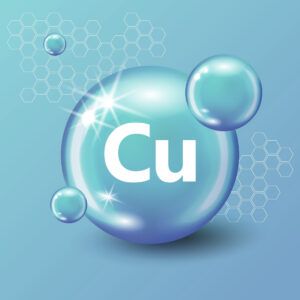
- Iron metabolism
- Maintaining healthy gut balance and histamine levels
- Bone structure
- Proper immune inflammatory response/general immune function
- Fat and cholesterol metabolism
- Neurotransmitter metabolism
- Psychological well-being
- Thyroid hormone production
- Connective tissue maintenance
- Acting as an antioxidant/reducing oxidative stress
- More
When copper is present in any form higher than the low, ideal levels (the recommended daily amount is 2mg), it is described as reaching a biounavailable state, and can no longer perform the above physiological necessities.
This is because copper is usable by the body and present in a bioavailable form when it is bound to a protein called ceruloplasmin. This is the main copper-binding protein, with up to 95% being bound to ceruloplasmin, the other transport proteins include metallothionein, albumin, and glutathione.
This is referred to as a transport protein because it is essential in order for copper to be transported successfully throughout the body to perform its various physiological tasks. The production of this protein is highly dependent on adequate adrenal and liver function – the adrenals stimulate production and the liver then manufactures and synthesizes ceruloplasmin.
As copper rises over time within the body, the adrenals become fatigued because of the developing physiological burden/stress and the liver becomes overloaded with excess copper, as the liver is the first place in the body that excess copper will begin to build up.
Both the adrenal glands and the liver then become sluggish and dysfunctional.
This then reduces the amount of ceruloplasmin and other transport proteins that are being produced, and hence allows unbound copper to freely travel through the bloodstream, accumulating within various tissues throughout the body.
Unbound copper can not be utilized, hence its existence in a biounavailable state.
As unbound, toxic copper levels rise, it will not continue to circulate throughout the bloodstream indefinitely, as the blood will remain free of anything that isn’t absolutely necessary for the majority of the time. It will become stored in cells and tissues/organs throughout the body.
When copper begins its initial rise above ideal levels, the liver is the first organ to become overloaded, followed by the kidneys, the brain, the reproductive organs, and more.
Free, unbound copper can be damaging and toxic to our body’s tissues and systems once it reaches and settles in them, manipulating proper function, causing oxidative stress, and chronic inflammation.
The singular mineral/heavy metal of copper, when present to any degree that is higher than its very minute “ideal” level, is a very powerful element that has the sole potential to effect the functioning and delicate homeostasis of our bodies in a myriad of ways.
This imbalance adversely affects:
- The endocrine (hormone) system – including the thyroid, adrenals, and sex hormones
- Cellular energy production
- The liver
- Kidneys
- Gallbladder
- Reproductive organs
- Digestive system and gut
- Neurological system and brain
- Lymphatic system
- Central nervous system
- Peripheral nervous system
- Methylation processes
- More
The phenomenon of high biounavailable copper is enigmatic, as when one is exhibiting toxic, very high levels of copper, they are physiologically experiencing a simultaneous copper deficiency. Their body is unable to use the high levels of copper present due to the fact that it is being stored, is unbound to transport proteins, and exists in a biounavailable state.
Due to this tandem toxicity/deficiency state, one will usually demonstrate many symptoms of copper deficiency, which can include:
- Anemia – in that copper is in part responsible for optimal red blood cell production and iron metabolism.
- Thyroid imbalance – in that copper is involved in the production of the thyroid hormone, thyroxine, or T4.
- Increased free radical damage – in that copper is responsible for serving as an antioxidant and lowering oxidative stress, as a cofactor for the important superoxide dismutase enzyme.
- Gut imbalance/candida infection/parasitic infection – in that copper is a natural anti-fungal and anti-parasitic and adequate zinc levels are needed to maintain optimal gut balance and intestinal lining integrity.
- Impaired neurotransmitter metabolism – in that copper is partly responsible for maintaining proper metabolism for neurotransmitters such as the catecholamines dopamine, norepinephrine, and epinephrine, as well as glutamate, GABA, serotonin, histamine and the MAO enzyme.
- Histamine imbalance – in that copper is a cofactor for the DAO/histaminase, histamine metabolizing enzyme.
- Decreased cellular energy production – in that copper plays a role in the final stage of cellular respiration,
called the electron transport chain. This process occurs within the mitochondria to produce ATP, one of the main and most important energy sources of the body. - Decreased bone density and tissue integrity – in that copper is responsible for building, repairing, and maintaining bone strength and connective tissue such as the skin, hair, nails, tendons, arteries, veins, ligaments, and others.
- Early greying of hair and skin pigmentation changes – in that copper plays a role in melanin production.
- Weakened immune response and susceptibility to infection – in that copper is responsible for creating an effective inflammatory immune response in the presence of infection, as well as being necessary for the proper function of T cells. Bioavailable copper also serves as a direct control and protection against anaerobic organisms.
- UTIs, parasitic infection, viral infection (such as Epstein Barr Virus), bacterial infection (such as H. Pylori), and fungal infection (such as Candida Albicans) are commonly seen in those with a copper
imbalance.
- UTIs, parasitic infection, viral infection (such as Epstein Barr Virus), bacterial infection (such as H. Pylori), and fungal infection (such as Candida Albicans) are commonly seen in those with a copper
There are also many additional symptoms that CT can include, which we will explore further below.
Copper and Estrogen
The relationship between estrogen and copper is a key factor of Copper Toxicity.
Our body depends on balance to function optimally, and was designed with a series of checks and balances to keep each interconnected system working well. In other words, the body is designed with each component having an intentional and functional relationship with the next.
Some of the main relationships involving the element of copper hold a great deal of weight when it comes to maintaining overall systemic balance.
One of these relationships is the close paralleled association between estrogen and copper.
Rising estrogen will encourage copper retention in the body. In addition, copper and estrogen tend to rise and fall together.
While both men and women have estrogen in their bodies, women house a great deal more, hence the higher prevalence of CT in women than in men, and the direct correlation between Copper Toxicity and estrogen dominance.
Estrogen dominance is a very common hormone imbalance that is essentially an imbalance between the 2 primary female sex hormones, estrogen and progesterone.
Estrogen and progesterone levels rise and fall according to the phases of the menstrual cycle which include menstruation, follicular, ovulation, and luteal. Each performs important designated tasks throughout the body.
Estrogen dominance can develop when there is a higher level of estrogen in relation to progesterone. Sometimes this doesn’t necessarily mean a high estrogen level, but a higher level than is appropriate in relation to progesterone.
There must be a balanced ratio between estrogen and progesterone for optimal health.
Estrogen dominance can be caused by:
- Exposure to xenoestrogens which are very common in our environment (explained further below in symptoms)
- The birth control pill
- Phytoestrogens such as soy which is also very common in many foods and products
- Biotoxin Illness (from mold exposure or Lyme)
- Chronic stress
- Obesity
- Poor liver function (excess estrogen is metabolized in the liver)
- Gut imbalance (excess estrogen is sent from the liver to the gut to be eliminated and gut imbalance can impede this)
- Expressive gene variants that limit proper liver detoxification and/or impact estrogen metabolism
Estrogen dominance can greatly contribute to the development of Copper Toxicity, and Copper Toxicity can also contribute to the development of estrogen dominance.
Estrogen dominance involves a great deal of symptoms all its own which can include:
-
- Breast tenderness and swelling
- Weight gain
- Bloating and lower abdominal pressure/fullness
- Water retention
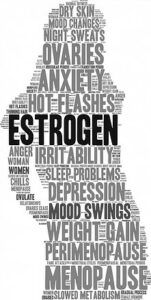
- Brain fog
- Anxiety
- Depression
- Hair loss
- Fatigue
- Insomnia
- Irregular periods
- Heavy periods
- Severe menstrual cramping
- Migraine headaches
- Acne
- Dry skin
- Uterine fibroids
- Hot flashes and night sweats
- Mood swings
- More
Copper and Zinc
Minerals all work together in a sort of dance within the body to perform a myriad of physiological tasks. There are a few significant mineral relationships which have an inverse, or antagonistic relationship with one another.
These mainly include:
- Zinc + copper
- Calcium + magnesium
- Sodium + potassium
Copper has an inverse relationship with zinc, one of the most powerfully important and multifunctional minerals in our body. When copper levels rise, zinc levels fall and vice versa.
Much more on the zinc mineral can be found here.
The ideal zinc to copper ratio is 8 to 1, respectively.
Symptoms
The symptoms of Copper Toxicity are many and present as both physical symptoms and mental/emotional symptoms because of the many ways that CT effects the body.
The symptoms usually present a bit differently person to person.
It is important to understand the concept of the “causal chain” when assessing the many symptoms that can arise from copper imbalance as well.
This concept refers to the unique physiological chain of events that occur within one’s body to manifest into various symptoms.
The following are a few common examples:
-
- Copper Toxicity → estrogen dominance → uterine fibroids, endometriosis, heavy periods, weight gain, irregular periods, hair loss, chronic fatigue
- Copper Toxicity → impaired iron metabolism → shortness of breath, chronic fatigue, pale skin, heart palpitations, easy bruising
- Copper Toxicity → low thyroid function → extreme chronic fatigue, weight gain, brain fog, insomnia, high cholesterol, depression, low body temperature, hair loss, slowed intestinal motility/constipation (the symptoms that can manifest solely due to thyroid dysfunction are numerous, as all of the body’s cells are influenced by the thyroid gland and thyroid hormones)
- Copper Toxicity → zinc deficiency → decreased digestive enzyme production/digestive disturbance, leaky gut (zinc is needed for intestinal mucosa integrity) – bloating, constipation, diarrhea, gas, autoimmunity – stomach ulcer (zinc is needed for stomach lining integrity), depression, anxiety, lowered immunity, hair loss, decreased libido, skin problems, chronic fatigue
- Copper Toxicity → liver congestion and sluggishness → weight gain, brain fog, malabsorption, chronic fatigue, bloating, decreased appetite, depression (the liver is responsible for over 500 physiological functions, and the symptoms relating to liver dysfunction are many)
- More
Each individual’s unique bioindividual factors such as genetics, lifestyle, health history, environment, diet, etc determine which causal chains will be responsible for their unique set of presenting symptoms.
Physical symptoms can include:
- Chronic fatigue and exhaustion, often extreme and debilitating
- Hair loss
- Dry, brittle hair
- Digestive upset
- Nausea
- Bloating
- Abdominal pain
- Body temperature fluctuations
- Night sweats
- Amenorrhea – cessation of the menstrual period
- Menorrhagia – very heavy menstrual periods
- High and low blood pressure
- Anemia
- Dizziness
- Heart palpitations and/or rapid heart rate

- Weight fluctuations
- Malaise
- Chronic pain
- Adrenal insufficiency
- Low thyroid function
- Estrogen dominance
- Endometriosis
- Breast cysts
- Migraines
- Skin problems
- Slow wound healing
- Muscle weakness
- Gut imbalance and infection such as candida/fungal overgrowth and parasitic infection
- Susceptibility to infection in general
- Abnormal gene expression
- Impaired ability to detoxify
- Poor circulation
- Vitamin and mineral deficiencies
- Pale stool due to lack of sufficient bile flow
- Hand tremors
- Body aches
- Tinnitus
- Shortness of breath
- Blurred vision
- Hypoglycemia
- Joint pain
- Histamine intolerance
- Food sensitives and environmental allergies
- Sensitivity to light
- Brain fog
- Insulin resistance
- High cholesterol
- Low libido
- Seizures
- Vertigo
- Difficulty conceiving
- Miscarriage
- Postpartum depression
- Osteoporosis
- Arthritis
- Bone spurs
- Skeletal imbalances
- Cardiovascular dysfunction
- Eating disorders
- Some cancers
- Alzheimer’s/cognitive decline
- More
Mental & emotional symptoms can include:
- Anxiety
- Depression
- Difficulty concentrating
- Brain fog
- Racing thoughts
- A sense of disconnectedness
- Schizophrenia
- More
Main Causes
Several of the main causes of Copper Toxicity include:
- Zinc deficiency and several other vitamin and mineral deficiencies
As mentioned above, zinc and copper have an inverse relationship, and a lowering of zinc will perpetuate an increase in copper.
Zinc deficiency is tremendously common today due to a wide variety of reasons:
-
- Our soil is pervasively depleted in zinc, hence a reduction in our food supply
- Increased chronic stress levels, which dramatically lower zinc levels in the body
- Use of pharmaceutical drugs can significantly lower zinc levels
- Gut imbalance and infection can lower zinc levels, which is a very common imbalance for many people today
In addition, deficiencies in copper balancing minerals and vitamins such as vitamin C, vitamin B6, molybdenum, and manganese also greatly catalyze the development of CT. These nutrients are mainly copper antagonistic and help to keep copper levels balanced.
A deficiency in preformed vitamin A can also contribute, which is in part responsible for the production of ceruloplasmin.
Poor dietary choices, the consumption of processed “foods”, conventional meat and dairy (which is loaded with added hormones, antibiotics, steroid drugs, and more), sugar and gluten containing grains all contribute to many chronic health issues, including gut imbalance and subsequent malabsorption of vital nutrients that maintain copper balance.
- Eating a mainly vegetarian diet
Vegetarian diets can be low in zinc which is again, the most copper antagonistic mineral and one of our biggest and most effective allies in keeping copper in balance. Also, vegetarian diets are often high in foods that are rich in copper such as nuts/seeds, beans/legumes, soy products, leafy greens, and grains.
Nuts, seeds, grains, and beans are also high in phytic acid and lectins (also known as “anti-nutrients”), which can bind to zinc and other vital nutrients and block their absorption.
Vegetarian diets can also be high in soy, which is often used in meat substitute products and other similar such products. Soy is a powerful phytoestrogen, which means that it can mimic the hormone estrogen in the body. Because of the relationship that copper has with estrogen, diets high in soy will encourage copper retention and the development of CT.
- Congenital/passed in utero
Copper imbalance can also be passed from mother to child, as this imbalance continues to increasingly prevail throughout successive generations. I was born with a relative copper imbalance, which continued to worsen over time.
A large reason why this imbalance has become increasingly prevalent in this generation is that the birth control pill and other forms of synthetic birth control were introduced in the 1960’s and became widely used. This in turn caused an increase in estrogen levels, which catalyzes an increase in copper levels amongst the eventual mothers who used them.
- The copper IUD

An intrauterine device, called an IUD, is a small T shaped device that is placed into a woman’s uterus to prevent pregnancy long term (usually up to 5 to 10 years). There are different forms of IUDs, each designed in a slightly different way to act as a contraceptive.
The copper IUD does not contain synthetic hormones, but it is a continuous feed of excess copper into one’s system.
Copper is used in a coil that wraps around the bottom of the T shape on the IUD. The copper then acts as a spermicide to prevent sperm from fertilizing a woman’s egg.
The copper IUD is often suggested as the “safest” form of birth control because it does not contain synthetic hormones. Many women therefore choose this option with the idea that they are choosing the most gentle option.
Unfortunately, the use of copper in a device that is placed inside the body for long periods of time is dangerous and can greatly contribute to the development of Copper Toxicity.
Each woman’s experience is a bit different, but copper imbalance and the first appearance of symptoms often presents as early as a month after insertion, or it can be up to a number of years.
- Copper supplementation and copper containing products
Copper is included in almost all multi-vitamin products, at the full daily recommended value, which is 2mg. Due to the fact that copper is present in almost all whole foods to some degree, most people are indeed acquiring their required daily amount via diet.
The scale can begin to tip in favor of excess copper when an overabundance is being consumed via a multi-vitamin supplement and other copper containing products.
- Hormone replacement therapy and/or simply being a woman
Women have more estrogen in their body than men. While CT can and does develop in men, women are more likely due to the close relationship between estrogen and copper.
- The birth control pill/any form of synthetic birth control
The birth control pill and most forms of synthetic birth control including most other IUDs all contain synthetic estrogen. This can strike an imbalance in estrogen levels and henceforth copper.
It seems as though most forms of conventional birth control methods can contribute to copper imbalance amongst many women, as they synthetically manipulate the natural balance of sex hormones and can contribute to the development of estrogen dominance.
I personally had the Mirena IUD for a short time, which worsened my case of Copper Toxicity.
- Stress/Adrenal Insufficiency
In today’s world, the majority of people remain in a low-grade, chronic stress state. This is due to an influx of all forms of stress, be it emotional, physical, or environmental.
The chronic occupation of the “fight or flight” stance equates to consistent stimulation of the amygdala in the brain, consistent stimulation of the adrenal glands to produce hormones such as cortisol and adrenaline/epinephrine, and a consistent occupation of the sympathetic nervous system.
This has a profound and systemic impact on the overall functioning of the body, as chronic stress can adversely impact all areas of health and well-being.
One of the main reasons that a chronic stress state significantly contributes to CT is that the adrenal glands are in part responsible for stimulating ceruloplasmin production, the copper binding protein that binds to copper, renders it usable and non-toxic, and safely transports it through the body.
As adrenal function declines and one continues to remain in this chronic stress state, the adrenal glands become significantly crippled to maintain their physiological responsibilities. Ceruloplasmin production declines, and unbound, toxic, “free” copper begins to circulate throughout the body and becomes stored in cells and tissues.
Another main reason that stress is a contributor to the development of CT is that all forms of stress cause the body to burn zinc rapidly, which leads to a zinc deficiency, and henceforth a copper toxic state.
- Copper cookware/copper water piping/well water supplies
Copper from copper cookware can be transmitted to foods during the cooking process. Copper water piping can be transmitted into the water that flows through them and remains stagnant in them for periods of time.
Well water can also contain high levels of many heavy metals including copper, lead, cadmium, and others.

- Dental amalgam fillings
Also referred to as “silver” fillings, amalgam dental fillings can contain up to 30% of copper.
Over 50% of this material is comprised of mercury, which is one of the most toxic substances in existence.
Amalgam fillings have been in use since the 1930s in the US, and are an antiquated, toxic medium to use in dental care.
Dental amalgams can and do catalyze severe chronic illness in many people and it is advised to have your dental amalgams removed and replaced by a trained holistic/”biological” dentist who strictly follows the “safe removal protocol,” also sometimes referred to as the “Huggins protocol.”
- Copper sulfate
This is often used as a form of pesticide/fungicide that is sprayed on fruits and vegetables.
- Xenoestrogens
These are synthetic compounds that mimic the hormone estrogen in the body, and henceforth encourage copper retention and Copper Toxicity.
These compounds, often also referred to as “endocrine disruptors” are extremely prevalent in today’s world. They can be found in plastics, household cleaning products, dryer sheets, personal care products (parabens, phthalates, and others), preservatives and “food” additives, conventionally-raised meats, pesticides, tap water, and others.
Copper Toxicity as a Common Core Underlying Cause
One of the most common scenarios in today’s medical community is to “diagnose” a symptom or set of symptoms such as “high blood pressure,” “anxiety & depression,” “bad periods,” or “chronic fatigue syndrome,” as if that symptom is the condition in and of itself.
The symptom is then treated with drugs or an invasive procedure that does not address what is truly causing that symptom/s.
The true core underlying cause therefore goes completely undetected and untreated.
Such is the case with Copper Toxicity in many cases.
A root cause focused paradigm shift is needed in order to be able to identify what is truly causing the very common chronic illnesses that are being experienced by millions of people in today’s world.
This paradigm shift recognizes the interconnected nature of our body’s systems and the paramount significance of vitamin, mineral, and nutrient balance to our overall health.
The only way to achieve true and lasting healing is to identify and treat the core underlying cause, support the body’s interconnected systems, and address the obligatory importance of individualized vitamin, mineral, and nutrient balancing as part of the overall treatment approach.
Wilson’s Disease
There is a genetic malady called Wilson’s Disease which is the only form of Copper Toxicity that is currently recognized in western medicine.
This is different that the form of Copper Toxicity that I am referring to here, and is much less common. It indeed involves a dysfunction in copper metabolism, yet is primarily associated with a variation in the ATP7B gene.
Symptoms of Wilson’s Disease include the presence of “Kayser-Fleischer” rings around the iris of the eye (brown/gold colored rings), speech imbalances, coordination imbalances, fatigue, abdominal pain, lack of appetite, muscle stiffness, and more.
Appropriate Testing Methods
One of the most important parts of assessing and treating CT is utilizing the most appropriate and accurate form of diagnostic testing.
- Hair Tissue Mineral Analysis (HTMA)
The primary form of testing that is most accurate in diagnosing CT is called Hair Tissue Mineral Analysis (HTMA). Blood testing is also helpful, however HTMA is the primary diagnostic tool.
HTMA is an effective, science-based method of testing that entails taking a sample of hair from the patient and testing it in a laboratory for its primary mineral and heavy metal content using a process called mass spectrometry. 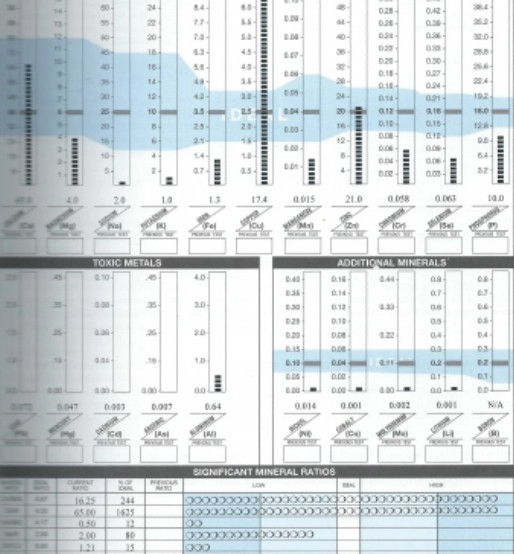
The blood tends to remain homeostatic, meaning it attempts to maintain balance by eliminating excesses and storing them throughout the body as opposed to keeping them circulating within the blood indefinitely.
The hair, however, is a much more telling medium to use in terms of giving an accurate picture of what is being stored in the body’s cells and tissues.
Each HTMA test will display one’s mineral and heavy metal status as it appears in the body over approximately a 3-month period of time.
Because our mineral level and mineral ratio patterns are closely linked to our glandular function and more, HTMA can also be used to determine one’s metabolic type, adrenal gland function, thyroid gland function, and blood sugar balance.
HTMA interpretation is a complex skill that must be done by a trained professional.
CT presents on HTMA tests in 2 primary ways. It can be overt, with a very high copper level, or “hidden.” “Hidden” refers to a state where excess copper is currently present primarily in cell and tissue storage, and is accessed via the interpretation of corresponding mineral and mineral ratio readings.
There are currently 2 labs in the US that process HTMA’s accurately:
- Analytical Research Labs in Phoenix, Arizona
- Trace Elements in Addison, Texas
Regular HTMA testing approximately every 3 months is important during the first 1 to 2 years of healing.
This is because your treatment protocol will shift in accordance to your shifting mineral readings, and having an accurate, up-to-date reading is key for making sure your protocol coincides with your current levels.
- Blood
There are two types of copper blood tests: total and free copper. Total refers to the copper in the blood that is bound to ceruloplasmin – essentially, the “normal” non-toxic form of copper.
Free copper refers to the copper unbound to ceruloplasmin – the toxic form. If examining the blood, this is the value that is most appropriate to consider regarding the assessment of a possible copper toxic state.
Red Blood Cell blood levels can also be tested for, as the RBC value is more accurate in determining the tissue stores of various minerals and nutrients. Again, however, many elements can manipulate blood readings, which must be taken into consideration.
As explained above, using the blood to gauge one’s true copper status is problematic in that it essentially depends on which state of copper accumulation or elimination one is experiencing as to what the blood will unveil.
Someone whom is indeed copper toxic can exhibit normal copper levels in their blood, as the blood is not where excess copper is stored.
Blood tests can be helpful in painting your total Copper Toxicity picture, yet should not be solely relied upon as a comprehensive diagnostic tool.
It is important to note here that blood testing is of course useful and needed when determining a number of other diagnostic elements such as thyroid function (free T3, free T4, TSH, etc) immune function (white blood cell levels, etc), and much more, but it remains secondary in assessing the true picture of one’s mineral and heavy metal status.
- Urine
There are tests that utilize a 24-hour urine collection period to test for minerals and heavy metals.
These tests can be inconclusive as well, primarily because one would need to be actively eliminating copper for it to appear in the urine.
One of the elimination pathways of copper is indeed the kidneys, however most excess copper is stored and will not be present in the urine unless being actively eliminated.
- Additional testing
There are a number of supplemental labs that can also be helpful as part of the overall diagnostic process.
For example, stool analysis (via comprehensive PCR analysis x 3) can be helpful to assess gut imbalance and the presence of infection. Or Organic Acids testing is helpful to determine the presence of expressive gene variants.
30-day saliva hormone panels can also be helpful in determining one’s sex hormone levels and pin pointing imbalances such as estrogen dominance as well.
These additional labs are all determined on a case by case basis with the help and guidance of your integrative health practitioner.
Copper Elimination
As was briefly mentioned above, copper elimination is a notable component of Copper Toxicity.
The primary elimination pathway of copper is through the liver, bile and into the intestines to be eliminated via the stool. It is also eliminated through the kidneys, and out via urine.
Copper is also eliminated via the hair and through the skin.
When copper is being eliminated from cell and tissue storage, it enters the blood on its way to the elimination organs.
This results in a temporary state of “copper poisoning.”
Copper elimination happens as a result of a copper balancing protocol, and can also happen if someone is copper toxic and experiences acute stress.
This state of “copper poisoning” often results in a temporary worsening of symptoms and can often include anxiety and racing thoughts.
It is very important when healing from CT to remain aware and mindful of how fast one is lowering their copper level, as it is not advised to eliminate copper too quickly. This results in a much too severe worsening of symptoms and is not good for the body overall.
Copper should be detoxed slowly and judiciously, as part of a comprehensive healing and mineral balancing protocol.
Treatment
Treatment for CT can be complex, and is always particular to the individual case per each person’s unique bioindividuality.
There are indeed several factors that should be included in all copper balancing protocols, however.
These include:
- Low Copper Diet
While most foods contain at least a small amount of copper, there are specific foods that contain high amounts which need to be limited while healing from CT.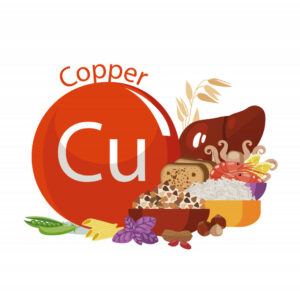
Some high copper foods include:
-
- Organ meats
- Shellfish
- Nuts & seeds
- Soy products
- Mushrooms
- Avocado
- Kale
- Yeast
- More
I will be including an entire article on what a Copper Toxicity eating plan looks like soon.
- Mineral Balancing Protocol
This is a unique supplement protocol that is based on your unique Hair Tissue Mineral Analysis readings. It can also include detoxification practices such as dry brushing, sauna therapy, and more.
This protocol shifts in accordance with your shifting mineral readings throughout your healing process.
Again, supplementation is different person to person, however some common examples of agents that can be used in a copper balancing protocol include:
-
- Judicious and careful use of copper antagonists: zinc, molybdenum, vitamin C, manganese, vitamin B6, and some others
- Anti-inflammatories such as omega 3 fish oil and curcumin
- Address deficiencies such as magnesium
- Thyroid support
- Adrenal support
- Potassium
- Digestive support and hydrochloric acid support
- Liver support
- Choleretic agents to encourage and optimize bile flow
- Binders which help to bind to heavy metals and facilitate their removal
- Estrogen metabolism support such as DIM and natural progesterone cream
- Gut healing agents
- And more
- Encouragement of Ceruloplasmin Production
Increasing production of this primary copper binding protein will render excess copper less toxic and facilitate its removal from the body. Ceruloplasmin also allows unbound free copper to become bioavailable.
Preformed vitamin A such as the form found in eggs and animal proteins is needed for ceruloplasmin production. In addition, whole-food sourced vitamin C, liver and adrenal supports, zinc picolinate, and the judicious use of sulfur amino acids are all also helpful for this purpose.
- Gut Healing
The gut is one of the most important areas to address within any healing protocol of any kind.
Our gut not only comprises the majority of our immune capacity, it is also highly responsible for the production and balancing of our body’s neurotransmitters (the enteric nervous system is found in the gut), ability to absorb and assimilate vital nutrients which keep us balanced, and ability to properly detoxify.
Addressing a possible “leaky gut” state, possible presence of gut infection (such as Small Intestinal Bacterial Overgrowth, candida fungal overgrowth, and/or parasitic infection), rebuilding probiotic presence, and more are all important to address.
- Supporting Detoxification
Supporting and encouraging the body’s ability to properly detoxify so that excess copper, excess estrogen, and other toxins can be successfully eliminated is a key part of healing.
This involves the use of binders as mentioned above, as well as supporting the body’s detox organs and elimination pathways.
These mainly include the liver, kidneys, and gut.
Encouraging detox via sweat is also highly effective in facilitating successful detoxification. This is done via the use of infrared sauna therapy, which is discussed much further here.
- Addressing of Additional Related Imbalances
Such as gut infections, endometriosis, bacterial infection, Biotoxin Illness, etc all of which require a specific approach that will be unique to the individual.
Safe removal and replacement of dental amalgam fillings is also encouraged.
- Lifestyle Adjustments
Lifestyle is huge for health and well-being and is a very important area to address on a CT healing protocol and any kind of healing protocol. Much more on a healthy and healing lifestyle can be found here.
- Stress Reduction
Also part of a healthy and healing lifestyle, stress reduction is a key component of healing from CT.
Stress not only slows healing but also contributes to the development of CT to begin with.
Utilizing tools such as journaling, light exercise, yoga, counseling/therapy, meditation, spending time in nature, spending time with the people you love, the Dynamic Neural Retraining System (DNRS), addressing possible trauma (more on this here), fostering self-love, and more are all helpful in reducing stress which greatly contributes to one’s healing.
I have done the DNRS program myself and it is an incredibly effective tool to use for many healing purposes including healing from Biotoxin Illness/Mold Toxicity, trauma, chemical sensitivities, optimizing detox ability, and more.
Click here to check out the program.
If you have any questions about my experiences please feel free to reach out! Also, an extended exploration of the program and my experiences can be found here.
- Optimizing Air Quality
Making sure one’s environment is free of mold and other environmental toxins is key to optimizing the body’s ability to detoxify and reach balance.
Using a good quality HEPA air purifier can be a powerful step in optimizing the air quality in your living space.
My Personal Experience with Copper Toxicity
For as long as I can remember, I had experienced various chronic symptoms such as digestive upset, chronic fatigue, and skin sensitivity.
Throughout my childhood and adolescence, I utilized mostly western/allopathic medicine to try to get to the bottom of what was causing my symptoms. Although I saw countless doctors and had countless tests performed, very little was determined and I was sent on my way.
I essentially learned to cope with my symptoms and tried to accept them as part of my life, trying my best to keep up along the way.
Around my mid-twenties, my existing symptoms worsened and many new ones emerged. I then sought out the aid of an integrative health practitioner and had my first Hair Tissue Mineral Analysis performed.
My results indicated a severe state of Copper Toxicity.
This determination was tremendously helpful, as this identified one of the main underlying causes that was at the root of my health struggles for all of those years.
I then began a comprehensive mineral balancing protocol and gradually balanced my copper levels over the course of the following several years.
Balancing my copper levels was a huge part of my healing.
Once this was accomplished, one of the most notable improvements was an emergence of physical energy that I had never experienced in my life up to that point. I did not know what it felt like to have energy all day long, as I had been tired all day every day for as long as I could remember.
If you have any questions about my personal experiences, please feel free to reach out by commenting below, emailing me directly at megan@healingjourneyessentials.com, or submitting the contact form on our contact page :).
HTMA Testing Services
Rick Fischer is a leading Hair Tissue Mineral Analysis practitioner as well as the instructor behind many of today’s HTMA practitioners. He is also a health coach, speaker, author, and expert leader in the field of mineral balancing and Copper Toxicity education and research.
Mr. Fischer offers HTMA testing services with Trace Elements, Inc.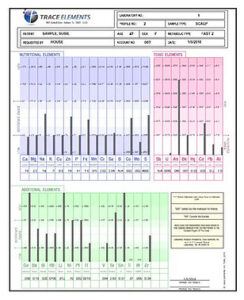
He works with clients worldwide, and offers a variety of packages to choose from that best suit your individual needs.
Mr. Fischer’s HTMA services can be found here.
⭐️Use code MEGANHEALTH at checkout for 5% off HTMA services. You will also find additional discount codes highlighted in yellow on the above HTMA services page 🙂⭐️
Mr. Fischer has been a colleague of mine for many years and I highly recommend his services, as he is very well versed in everything Copper Toxicity and mineral balancing in general. He is passionate about this field and integrative health in general and has a strong dedication to his clients.
To learn more about the huge significance of minerals and your health, click here to receive a free copy of the Mineral Secrets for Optimal Health ebook!
Continued Education: Mineral Mastery Course
The Mineral Mastery course is a 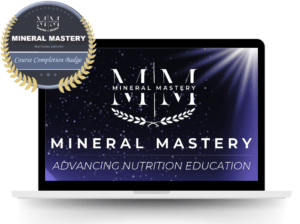 comprehensive self-paced online course that was developed by Rick Fischer as well.
comprehensive self-paced online course that was developed by Rick Fischer as well.
This is an excellent way to continue learning all about minerals and common mineral imbalances. You will also learn all about the key roles that minerals and mineral balance plays in your health and well-being and how imbalances in this area can contribute to illness.
These are key understandings to have, as mineral balance plays such an integral and foundational role in our overall health and well-being.
You will receive lifetime access to the course upon your purchase.
⭐️ You may use code “meganhealing” at checkout for 30% off of your tuition cost 🙂 ⭐️
This is a 10 unit course which covers the following topics:
- Unit 1: Introduction
The common nutritional misconceptions and why this information is so vital in order to advance our understanding of health and the application of nutrition.
- Unit 2: Calcium & Magnesium
The reasons why most people have an imbalance in these two very important minerals, and the serious health implications that can result when left unaddressed
- Unit 3: Testing Mineral Status
Most mineral imbalances go unrecognized when looking solely at the blood level. This unit examines the benefits and drawbacks of testing blood vs. urine vs. HTMA (hair analysis)
- Unit 4: Sodium & Potassium
As another commonly seen imbalance, this unit examines why potassium is so underappreciated, and the simple mistakes most people make.
- Unit 5: Copper & Zinc
This silent and greatly misunderstood epidemic imbalance has profound implications on overall health and should be on the radar of every single woman.
- Unit 6: Additional Minerals
This unit examines additional minerals such as iron, chromium, boron, selenium, iodine and more.
- Unit 7: A Few of the Vitamins
This unit examines how each individual’s need for specific vitamins is largely determined by one’s mineral system. Vitamins A, C, and D are explored, including their connection to the mineral system, and the common mistakes made with each.
- Unit 8: Toxic Metals
Learn how to use your mineral system to protect your body against the adverse effects of common toxic metals that we’re all exposed to, including mercury, aluminum, arsenic, cadmium, and more.
- Unit 9: Detox Approaches
Over-simplified and one-size-fits-all approaches often miss the mark when it comes to detoxing. This unit presents specific approaches for addressing the detox of copper, along with other toxic metals.
- Unit 10: Minerals and Human Energy
A special unit for anyone who wants to increase their energy or find the root cause of their fatigue. From minerals and beyond, this unit truly helps to connect the dots.
Click here to check out the course.
⭐️ You may use code “meganhealing” at checkout for 30% off of your tuition cost 🙂 ⭐️
In Closing…
As we’ve explored here, Copper Toxicity is a multifaceted condition that is quite common today but not yet well known within either medical community.
If you suspect that you may have a copper imbalance, acquiring appropriate testing is the best first step.
Copper Toxicity is healed the most successfully by utilizing a multipronged approach that honors bioindividuality and the unique needs of your particular case.
Awareness is key, and continuing to learn about minerals and the importance of mineral balance to our health and well-being is an excellent additional step throughout your health and wellness journey.
If you or someone you love is currently moving through the challenges associated with Copper Toxicity, I extend my deepest empathy and send you lots of love.
You will heal. Your future is so bright 💜.
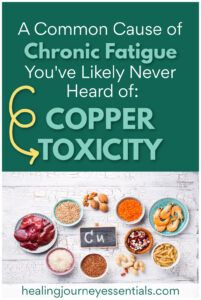
REFERENCES
Reference 9: Analytical Research Labs, Inc. Hair Tissue Mineral Analysis reports. Phoenix, AZ. 2013-2016
Reference 10: Beech, Dr. “High Copper Alloys for Dental Amalgam.” International Dental Journal 32.3 (1982) : 240-251
Reference 11: Chatsworth, Colin & Loren, Eck, Dr. Paul C. Energy: How it affects your emotions, your level of achievement, and your entire personal well-being. Sam Biser Press.
Reference 12: Eck, Dr. Paul C., Wilson, Dr. Lawrence. “Copper Toxicity.” Eck Institute of Applied Nutrition and Bioenergetics, Ltd. (1989) : 1-12.
Reference 13: Freedman, Jonathan H., Ciriolo, Maria Rosa, Peisach, Jack. “The Role of Glutathione in Copper Metabolism and Toxicity.” The Journal of Biological Chemistry 264.10 (1989) : 5598-5605
Reference 14: Gittleman, Ann Louise. Why Am I Always So Tired?. HarperCollins Publishers, 1999.
Reference 15: Maintz, Laura, Novak, Natalija. “Histamine and Histamine Intolerance.” The American Journal of Clinical Nutrition 85.5 (May 2007) : 1185 – 1196.
Reference 16: Mailloux, Richard, B.S., Pfeiffer, Carl C., Ph.D, MD. “Excess Copper as a Factor in Human Diseases.” Journal of Orthomolecular Medicine 2.3 (1987) : 171-182.
Reference 17: Malter, Rick, Ph.D. The Strands of Health: A Guide to Understanding Hair Mineral Analysis. 2003.
Reference 18: Waller, Pip. Holistic Anatomy: An Integrative Guide to the Human Body. North Atlantic Books, 2010.
Reference 19: Warner, Laurie. “Copper-Zinc Imbalance: Unrecognized Consequence of Plant-Based Diets and a Contributor to Chronic Fatigue.” Wise Traditions in Food, Farming, and the Healing Arts – Weston A. Price Foundation (Spring 2007).
Reference 20: Watts, David L, DC, Ph.D. “The Nutritional Relationships of Copper.” Journal of Orthomolecular Medicine 4.2 (1989) : 99-108.
Reference 21: Vernon, Theresa. “Metals and the Mind.” Wise Traditions in Food, Farming, and the Healing Arts – Weston A. Price Foundation (Winter 2008).

This is certainly an extensive and comprehensive artical on copper toxicity. It would be highly valuable, as a resource, even to professionals in health care. You have really stressed the value of copper is an essential micro mineral/trace element, when in the appropriate amounts witin the body. it is absolutely essential. On the other hand, you have stressed that too much copper causes copper toxiicty and is very damaging to one’s health as it leads to progressively worse health conditions as it builds up in our bodies. The liver and the adrenal glands are very important to the functions in the body and so overall systemic balance is destroyed .if this metal is out of balance. You have stated that the first step is to get tested to see where your levels of minerals are. Is there a place that you could recommend for such testing?
Hello! Thank you for your comment :).
Copper is a fascinating mineral/heavy metal in so many ways, especially regarding the proper balance that is necessary for it to fulfill its important physiological roles, without tipping too far in the direction of toxic, high levels. Balance is key regarding so many facets of our health.
Sure! 🙂 My recommendation for a superior HTMA testing service can be found in the “HTMA Testing Services” section, toward the bottom of the article. Rick Fischer offers HTMA testing services through the mail worldwide through the Trace Elements HTMA lab, more information can be found here.
Thank you so much and I wish you all the best in your journey! 🙂
Hello. What I do know is that copper toxicity can be caused by genetic conditions or exposure to high levels of copper in food or water. Copper toxicity is often caused by inadvertently ingesting too much copper from water supplies that contain high levels of copper. Water can be contaminated by farm work or industrial waste that leaks into nearby reservoirs or public wells.
Hi Bojana! Thank you for your comment :). You are absolutely right, Copper Toxicity can indeed be caused by genetic conditions and excess copper can be acquired via all of the sources you mention.
All the best to you!
Thanks for sharing this educative and eye-opening article on copper toxicity. You also added your own personal experience. I found it quite disturbing at first because of the high prevalence of women until I got to your own story. I think every woman needs to see this in order to start taking precautions, especially with the use of IUCD as a family planning method.
I am happy that with some lifestyle changes as a woman, the chances of getting copper toxicity will be reduced.
Hi Bethel! You are most welcome! Thank you for your comment :). I totally agree with you, every woman should be educated on Copper Toxicity to be able to best support her health and avoid these imbalances. Over time, I am hopeful that awareness will grow.
Absolutely, this awareness coupled with the appropriate lifestyle adjustments are excellent steps in nurturing your health and wellness.
Thank you and I wish you all the best in your journey! 🙂
Hi,
I have just recently heard about copper toxicity. I am trying to make sure I make my retirement, when it comes, as healthy as possible!
As we age, it’s important to think about ways to stay healthy and enjoy a long retirement. One thing I am now considering is copper toxicity, which can cause a wide range of health problems. Here are three reasons why I want to avoid copper toxicity in my retirement years:
1) Copper toxicity can cause nerve damage and cognitive decline. This can make it difficult to enjoy life and participate in activities you love.
2) Copper toxicity can damage the liver and other organs. This can lead to a host of health problems that make retirement less enjoyable.
3) Copper toxicity can cause skin problems and hair loss. This can be embarrassing and make you feel self-conscious about your appearance.
Thanks for a great article!
Hi Julia! Thank you so much for your comment :). You are most welcome! Copper Toxicity is indeed a far-reaching condition and can have a myriad of significant impacts on our body and our health, including all of the 3 points that you included. It is so wise of you to take all of these important elements into consideration in ensuring that you have the most wonderful and healthy retirement. May it be the very best for you, enjoy! 🙂